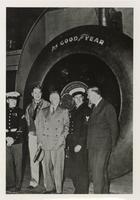(6,581 - 6,600 of 10,081)
Pages
-

-
Title
-
Admiral Richard Byrd, Thomas Poulter, and the Snow Cruiser crew, 1939
-
Date
-
1939
-
Description
-
Photograph of the Antarctic Snow Cruiser crew (Left to right: Sargent Felix Ferranto, Dr. F. Alton Wade, Admiral Richard E. Byrd, CPO Charls...
Show morePhotograph of the Antarctic Snow Cruiser crew (Left to right: Sargent Felix Ferranto, Dr. F. Alton Wade, Admiral Richard E. Byrd, CPO Charls Meyer, Dr. Thomas C. Poulter) in front of one of the Snow Cruiser's ten-foot-tall Goodyear tires. The Snow Cruiser was designed by Armor Research Foundation Scientific Director Thomas C. Poulter, constructed by ARF, and taken on Richard Byrd's third Antarctic expedition. This photograph originally appeared in the December 1939 issue of the Armor Engineer and Alumnus. Photographer unknown.
Show less
-
Collection
-
Office of Communications and Marketing photographs, 1905-1999
-

-
Title
-
Making A Hot, Arid, Desert Arab City More Livable: Investigating the Role of Street Design in Enhancing Walkability in Riyadh, Saudi Arabia
-
Creator
-
Almahdy, Omar Esam
-
Date
-
2020
-
Description
-
Since the introduction of automobiles in the 1950s, cities in Saudi Arabia have evolved around an automobile infrastructure. Riyadh, the...
Show moreSince the introduction of automobiles in the 1950s, cities in Saudi Arabia have evolved around an automobile infrastructure. Riyadh, the capital city of Saudi Arabia with a population of over 7.2 million, is facing an urban mobility challenge. For most inhabitants, driving is the only transportation available, since there is not yet an efficient public transit system. Currently, contemporary urban streets in Riyadh are limited to automobiles and inaccessible to pedestrians. Creating a walkable environment and improving walkability could solve numerous problems like the obesity crisis, the lack of city vibrancy, traffic congestion, environmental injustice, and social isolation. In this research, I investigate the climatic, geographic, social, and cultural factors that influence walkability in Riyadh as a hot, arid, and desert Arab city. The study uses mixed methods that include structured streetscape observations and pedestrian activity mapping as well as surveys and interviews with Riyadh’s citizens. Also, more data were collected through interviews with experts in Saudi urban planning and development. The issue of walkability in Riyadh extends beyond the design of the built environment. Many non-physical barriers hinder people from walking. Again, the perception of the streets as thoroughfares for automobiles only has deepened the problem. However, the lack of adequate sidewalks on most streets is the main reason why people do not walk. Also, this lack is a critical indicator of the dearth of efficient and proper urban design. The harsh climatic conditions along with the occasional sandstorms as well as polluted ambient air make the walking experience uncomfortable most of the year. To sum up, this study indicates that people’s awareness of the value and importance of having walkable streets and minimizing the reliance on motorized transport modes is a key driver in creating a pedestrian-friendly street.
Show less
-

-
Title
-
A Randomized Controlled Trial of Direct-to-Consumer Advertising of Cognitive-Behavior Therapy for Depression
-
Creator
-
Antler, Caroline
-
Date
-
2020
-
Description
-
Almost half of individuals in the US struggling with depression never seek treatment and, of those that do, over half receive inadequate care....
Show moreAlmost half of individuals in the US struggling with depression never seek treatment and, of those that do, over half receive inadequate care. Although the efficacy of CBT for MDD is well established, the rate of individuals receiving psychotherapy has declined. With copious evidence supporting the effectiveness of direct-to-consumer advertising (DTCA) of pharmaceuticals, the current study evaluated the potential utility of DTCA of CBT for MDD.One hundred seventy-eight adults with (a) prior exposure to DTCA for antidepressants and (b) no mental health diagnoses or treatment were randomly assigned to view one of three video conditions: CBT for depression (CBT, n = 60), CBT plus information on antidepressants (CBT+MED, n = 58), or Control (arthritis and diabetes Public Service Announcements (PSAs); n = 60). After viewing the video participants completed measures of attitudes about, and willingness to engage in, CBT and antidepressant medication. The study was conducted online with participants being recruited through Prolific and the survey created via Qualtrics.Compared to controls, participants viewing CBT DTCA videos (with or without information on antidepressants) were more willing to engage in CBT, had less public and self-stigma associated with CBT, and believed CBT has less potential for harm. Compared to the CBT group, the CBT+MED group reported greater concern about the risks of disclosing personal information in a therapy setting.These results extend previous findings by applying the DTCA marketing style to a specific diagnosis and type of therapy. Findings indicate that DTCA-style ads for CBT for MDD can be effective in reducing stigma and increasing treatment willingness. They further suggest that DTCA-style marketing of evidence-based psychotherapies can be efficacious when created for specific treatments and disorders. The findings have substantial implications for public health and the dissemination of evidence-based practice.
Show less
Pages